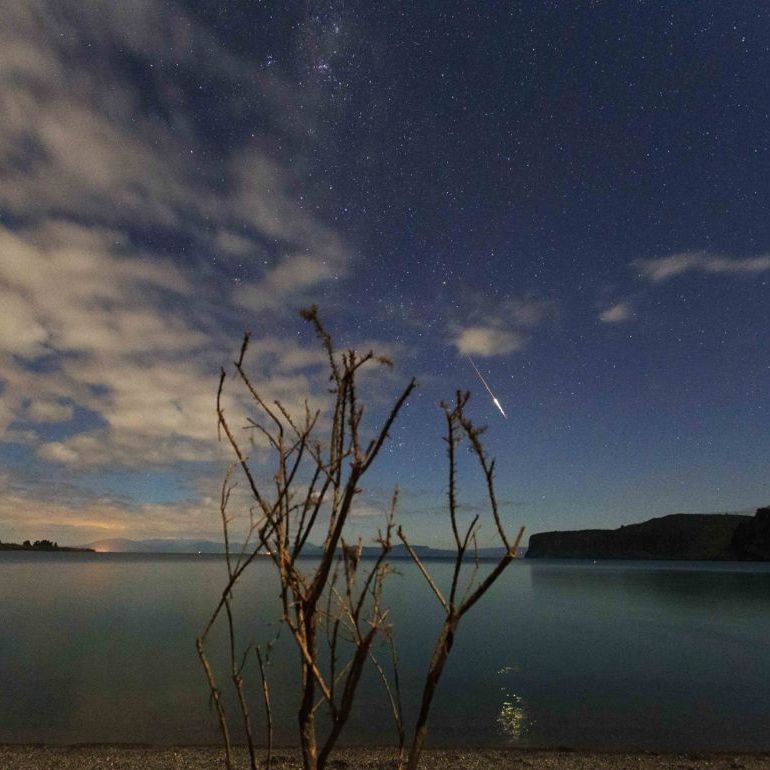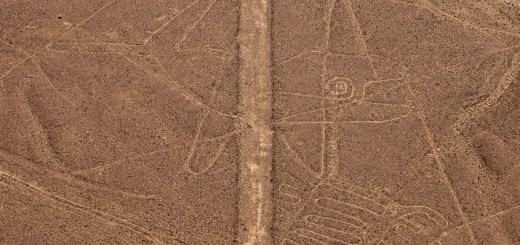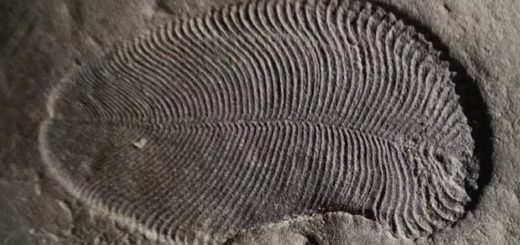Taupo Supervolcano Needs Monitoring, Scientists Say

When we in the U.S. think of supervolcanoes, we’re likely to think of Yellowstone. But people in New Zealand think of Taupo. Supervolcanoes are some 1,000 times bigger than a normal volcano. Earth’s last supereruption was Taupo, approximately 25,000 years ago. Taupo has erupted less violently at least 28 times since then, with the largest and most recent of these events occurring in 232 CE. A new study published this month confirms that Taupo is currently active and potentially hazardous. The study – published June 7, 2021 – revealed that Taupo has an active reservoir of at least 60 cubic miles (250 cubic km) of magma beneath its caldera. The scientists said some 20-30% of this magma is molten.
The study followed a period of unrest around Taupo in 2019.
The caldera of Taupo volcano long ago filled with water and is now a large lake in the center of New Zealand’s North Island. A town of 25,400 people (as of June 2020) rests along a bay in the lake’s northeastern shore. The lake and the town are both also called Taupo.
The peer-reviewed journal Geochemistry, Geophysics, Geosystems – a publication by the American Geophysical Union – published the new study on June 7.
In historical times, Taupo has undergone periods of unrest involving abundant, sometimes damaging earthquakes and ground deformation. 2019 was one of these periods of unrest. Scientists used the locations and patterns of the earthquakes and ground deformation to infer the presence of the active magma reservoir beneath the lake. They said that new magma being fed into this reservoir is what caused the triggering of earthquakes in 2019. These scientists said in their paper:
Our findings show that Taupo needs to be carefully monitored to better understand the processes at depth and the factors that might cause similar unrest to escalate into an eruption in the future.
Lake shaped like Africa seen from above, above Taupo supervolcano.
Lake Taupo – the water-filled caldera of the Taupo volcano – is the largest lake by surface area in New Zealand. It has a surface area of 238 square miles (616 sq. km). Image via Dougal Townsend/ GNS Science/ EOS.
New Zealand is a land of volcanoes
New Zealand lies along Earth’s Ring of Fire, a horseshoe-shaped swath around the Pacific Ocean – 24,900 miles (40,000 km) long – dotted with volcanoes. Most of Earth’s earthquakes and volcanic eruptions happen along the Ring of Fire.
Taupo wasn’t the only volcanically active region in New Zealand in 2019. The 2019 Whakaari, or White Island, eruption took place on December 9, 2019. The island was a popular tourist destination, and 47 people were on the island at the time. According to Wikipedia:
Twenty-two people died in the explosion or from sustained injuries, including two whose bodies were never found and were later declared dead. A further 25 people suffered injuries, with the majority needing intensive care for severe burns.
The day after the White Island eruption, Robin George Andrews, a volcanologist and science journalist, told the Washington Post:
New Zealand, especially its North Island, is just riddled with volcanoes
They’ve carved out one of the most naturally beautiful places on Earth, but at the same time, it’s prone to devastating earthquakes and horrific volcanic eruptions. It’s the price tag of that.
Volcano surrounded by ocean, with smoke pouring from its caldera.
The volcano on White Island, a small New Zealand locale frequented by tourists, erupted in 2019, killing 22 people. Image via George Novak/ New Zealand Herald/ AP/ Washington Post.
Earth’s most recent supereruption
A supervolcano is vastly more powerful than an ordinary volcano. By definition, it erupts at magnitude 8 on the Volcano Explosivity Index. That means that, at one point in time, it erupted so powerfully that it released more than 240 cubic miles (1,000 cubic km) of material.
Yellowstone, 2.1 million years ago, is the largest supereruption known, but Taupo, approximately 25,000 years ago, is the most recent. At that time, it produced 271 cubic miles (1,130 cubic km) of debris.
Scientists give names to the various supervolcano eruptions. The Taupo supereruption of 25,000-some years ago is the Oruanui eruption. This was the largest volcanic eruption on Earth in the last 70,000 years. Debris covered North Island up to 660 feet (200 m) deep, or what would be equal to all of California buried under 9 feet (2.8 m) of debris.
Since Taupo’s supereruption 25,000 years ago, no other volcano on Earth has ejected more material.
The more recent (232 CE) Taupo eruption was named the Hatepe eruption. It wasn’t a supereruption, but it was the most violent eruption on Earth in the past 5,000 years, ejecting 7.2 cubic miles (30 cubic km) of material in just a few minutes, and some 29 cubic miles (120 cubic km) of material overall.
Map of Lake Taupo and underlying calderas.
This map shows Lake Taupo and the calderas below the lake from the most recent eruption (Taupo Caledera) in 232 CE and the last supereruption (Oruanui Caldera), 25,000 years ago. Image via EOS.
What would happen if Taupo erupted today?
For the last 1,800 years, Taupo has been relatively quiet, with various periods of unrest marked by an increase in earthquakes and observable ground deformation within the caldera, as happened in 2019.
Scientists measure the increased activity in order to estimate the size of an active magma reservoir beneath the caldera. New magma feeds into this reservoir, triggering earthquakes in the surrounding brittle crust along local fault lines. In a March 2020 article in EOS, scientists said that:
… the mushy magma system below the volcano today has rebuilt to a substantial size (hundreds of cubic kilometers) and is capable of generating volumes of eruptible magma within only a few years to decades, a geologically rapid timescale.
Another supereruption at Taupo is an extremely remote possibility, scientists say.
However, the more recent unrest at Taupo, with earthquakes and deformation in the caldera, shows that potentially hazardous future eruptions are a concern for local residents.
An eruption at Taupo would affect the great lake named for the volcano that lies at the center of North Island. Lake Taupo is the biggest freshwater lake in Australasia by volume. Taupo is also of cultural significance to the indigenous Maori, who came to the area around 1300 CE. North Island was unpopulated during its most explosive volcanic events. But currently, 77% of New Zealanders live on North Island, with the biggest cities scattered around the periphery of the island, on the coasts. A city of some 25,400 residents, also named Taupo, lies on the northeastern shore of the lake.
Satellite image of supervolcano Taupo with imagined eruption plume.
This NASA satellite image is enhanced with a volcanic plume over Taupo, showing what the Oruanui eruption 25,000 years ago may have looked like from space. Image via Wikimedia.
How scientists are monitoring Taupo
Taupo is part of an active tectonic rift. In this region, Earth’s crust is pulling apart toward the west and east at about 0.4 inches (1 cm) a year. Therefore, earthquakes occur that are unrelated to the volcano. Scientists wrote in EOS in 2020 that:
The presence of the rift makes it difficult to distinguish earthquakes that are related to volcanic unrest from those that are part of the background dynamic environment [the larger tectonic movement of Earth’s crust].
Normally, in an average year, the Taupo region experiences several hundred earthquakes. In 2019, the seismic network picked up 1,100 earthquakes, with swarms starting in late April. The biggest earthquake felt that year was on September 4, when a 5.2 magnitude temblor shook the area. It was the largest earthquake beneath the volcano since 1952. Scientists measured the earthquake at a depth of 3 miles (5 km), which is in the range of where the magma chamber probably lies.
Before the 2019 unrest, the national seismic sensor network was scanty near Taupo, with just five sensors within 6 miles (10 km) of the caldera. This small number of monitors made it difficult to detect and locate smaller earthquakes, especially their depths.
Nowadays, many researchers who study Taupo do so under a program called ECLIPSE, which stands for Eruption or Catastrophe: Learning to Implement Preparedness for future Supervolcano Eruptions. They’ve been working to install 13 more seismometers, with the goal of getting a more accurate picture of the earthquake strength and depth in this region.
The researchers install the seismometers in cooperation with the local Maori tribes, in locations chosen to coincide with different family groups that have helped them avoid placement at sacred sites. Outreach and science education is a part of the program, to provide meaningful communication of the possible dangers in the landscape.
The following video gives more information about the unrest at Taupo volcano. The video was made five years before the most recent period of unrest in 2019.



 Creators of mankind
Creators of mankind Description of “Tall white aliens”
Description of “Tall white aliens” Where they came from?
Where they came from? About hostile civilizations
About hostile civilizations The war for the Earth
The war for the Earth “Tall white aliens” about eternal life
“Tall white aliens” about eternal life Video: “Nordic aliens”
Video: “Nordic aliens” Aliens
Aliens Alien encounters
Alien encounters The aliens base
The aliens base UFO
UFO Technology UFO
Technology UFO Underground civilization
Underground civilization Ancient alien artifacts
Ancient alien artifacts Military and UFO
Military and UFO Mysteries and hypotheses
Mysteries and hypotheses Scientific facts
Scientific facts


















